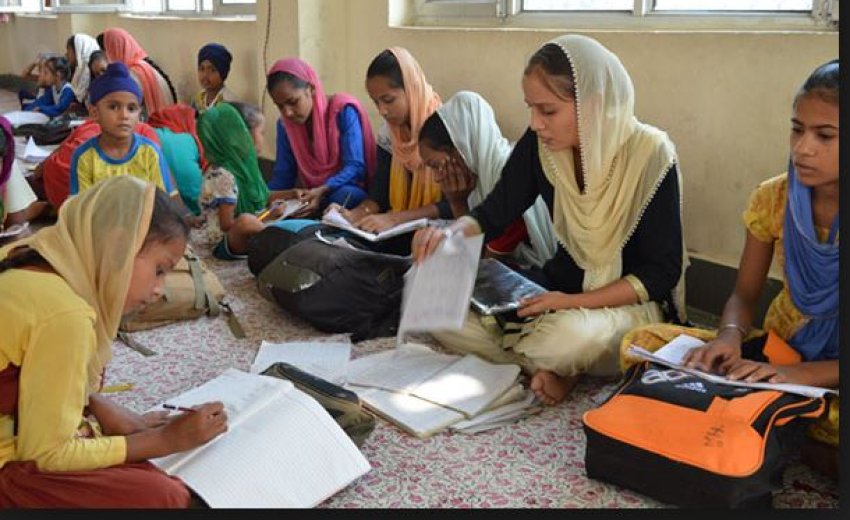SIKHLIGAR GHETTO, SHOLAPUR: Meet Poonam Kaur. 12 years old, wearing a simple salwar kameez with the dupatta over her head, demure, shy but knowledgable. She knows that the Prime Minister of the country is Manmohan Singh. She also knows that the young sons of Guru Gobind Singh were seven and nine years old when they were bricked alive. What she does not know is how her parents did and forefathers land up in a filthy ghetto in the heart of this city.
Meet Sonu Singh. He studies in the eighth standard. He uses basic water colours to paint Bolllywood stars and artistes. Besides regular school, he attends National Cadet Corps sessions. He has no spare time. As soon as he returns home, he does not do home work, he works with his father to convert old drums into usable agricultural equipment. He too does not know how his parents landed up in this place, called Dera by the inhabitants and otherwise derogatorily called, Basti.
These are two of thousands of such children of Sikhs who form part of a section of the Sikhs, called Sikhligaar Sikhs. In Maharashtra alone, their number is nearly six thousand. Just a hundred kilometers from Sholapur is the hometown of Bhagat Namdev, whose Bani is included in Guru Granth Sahib. The other two Bhagats- Bhagat Trilochan and Bhagat Ramanand whose Bani is included in Guru Granth Sahib are also from this region. Takht Hazur Sahib is also not very far away.
The Tercentenary Gurta Gaddi celebrations were an opportunity for fifteen of them to go to Hazur Sahib and partake Amrit. Some of them proudly told me that they ‘get up at Amrit vela and do paath.”
Living in abject penury, far from their homeland Punjab, with virtually no connection with Sikh thought and the Sikh world, they are ironsmiths who eke out a daily living by making utensils, knives and agricultural implements. Whatever little history is available, tells us that they were weapon-makers since the times of the sixth Master, Guru Hargobind Sahib.
Learning the skills through the generations, even today they produce excellent hand crafted Kirpans and other hand-fighting gear. While it may not be wise to categorise the martyrdom according to caste or origin, it is said that a number of martyrs were from this section of the Sikhs including Bhai Dayala, Makhan Shah Lubana and Bhai Mani Singh.
A ‘prosperous’ Sikh community somehow forgot them for some two hundred years or so. They did not forget their roots. Travelling from one part of Maharashtra to Karnataka to Andhra Pradesh to wherever they could get a foothold, they became a nomadic tribe –unsettled, unread and unattached.
Significantly, this became their strength. No amount of Christian or Brahaminical influence could take them away from their roots. Knowing only the name of Guru Nanak and Guru Gobind Singh, they stuck to their fundamentals –their Kesh are intact and they have the crowning glory of Turban on their heads.
No one knows their exact numbers. From the lakhs to the thousands –described with various nomenclatures -nomadic tribes, scheduled castes and scheduled tribes. Each Indian state has a different categorization for them and the Sikh world simply calls them Sikhligar Sikhs.
The sheer numbers have been off-putting to some. Others see it as a hope of strengthening the demographic power of the Sikhs. Hopefully, we will have the first-ever official census of Sikhligar, Vanjara and Lubana Sikhs in the coming months thanks to the efforts of the National Commission for Minorities. NCM member Harcharan Singh Josh, told this correspondent that, “it took two years to convince the NCM co-members that Sikhs too are poor, in fact, these Sikhs are poorest of the poor –living below the poverty line.” Extensive field studies have been undertaken by the NCM all over the country and a report is expected soon.
Poverty and pressure of the police have known to subdue many a people in settled societies. Not the Sikhligar Sikhs. In Sholapur, the police harass them whenever there is trouble even though they are not even remotely involved in any way. In this particular ghetto, the families living cheek by jowl under tin and thatched roofs do not pick up fights every now and then. One of their coordinators proudly said, “We have no police case pending against any of us.”
Their temporary habitat is now in danger. Galloping land prices in towns and cities due to a skewed development model of Special Economic Zones and malls has resulted in threats to those Sikhligars who are settled in shanties on the outskirts of cities like Hyderabad. Those living here too do not own the lands though living at this particular spot for more than thirty years.
This chapter of Sikh history is ready by many and flipped over. Not any more. I accompanied Balvinder Singh and Sanmeet Kaur, software engineers from Bangalore and Kulwant Singh -a mechanical engineer and Jaspal Singh – a lab technician from Mumbai, who are part of a silent educational revolution for the Sikhligar brethren. They are optimistic activists who instead of crying over and repeating the problem ad-nauseam, are part of a movement called Akhar –Service of Humanity, initiated by young Sikh professionals from Bangalore. Working alongside Guru Gobind Singh Study Circle Maharashtra and Gurmat Missionary College Mumbai, these and other volunteers have ‘adopted’ this ghetto and three other localities in Jalgaon, Ichalkaranji and Srirampur in Maharsahtra catering to the needs of 200 children.
Every few weeks, they visit these ghettos, stay there and monitor the education and sanitation programme launched for the kids that live in sub-human conditions.
It is time to be part of the solution so that as we eye 400 years of Guru Granth Sahib, we are sure that ‘Sikhs being illiterate is a rumour.’ Would you like to join them?
Jagmohan Singh may be contacted at [email protected]

